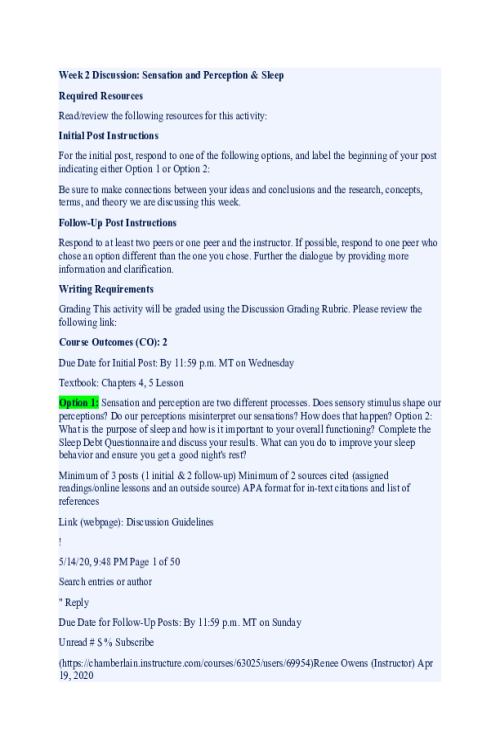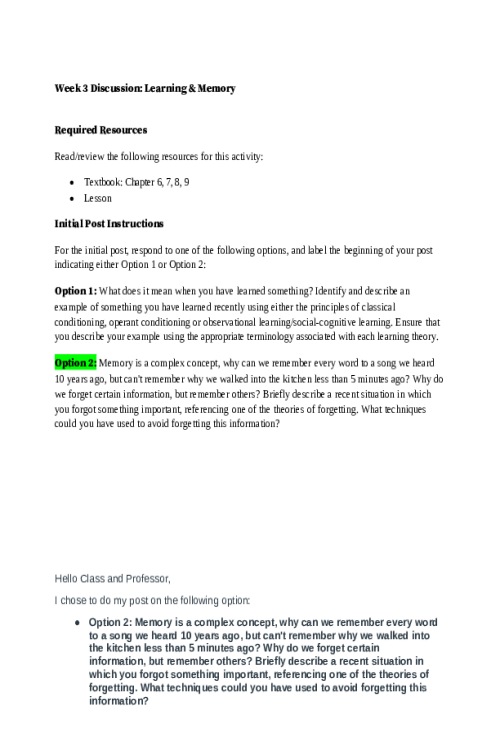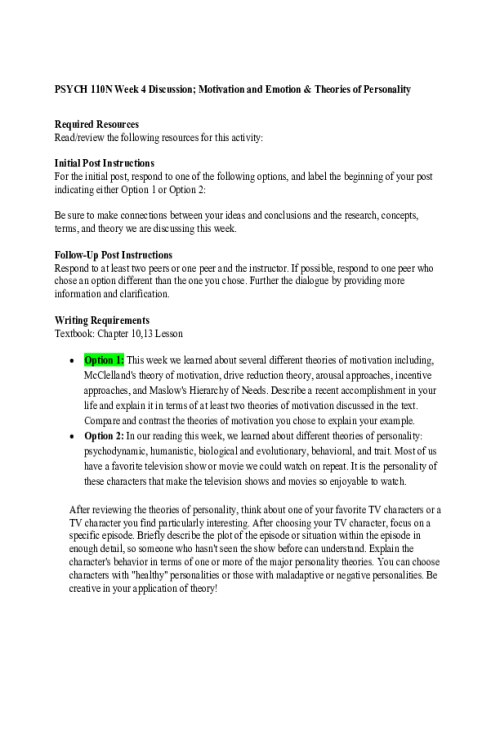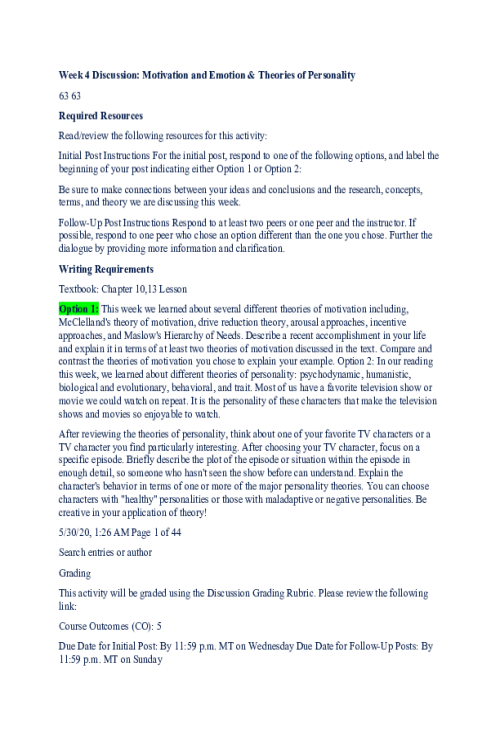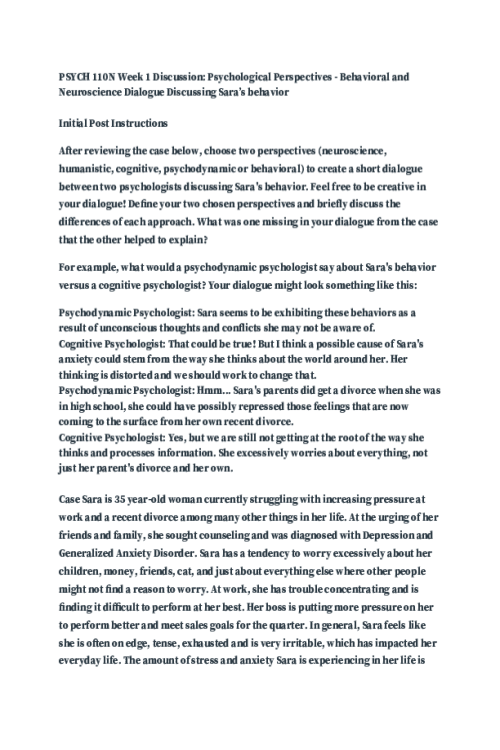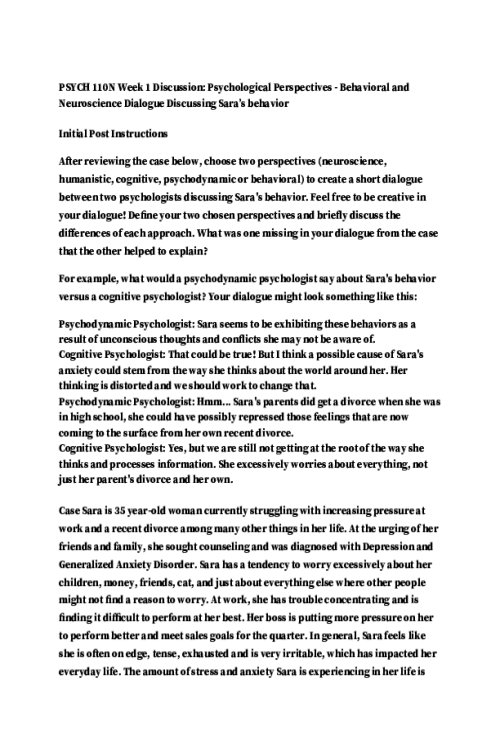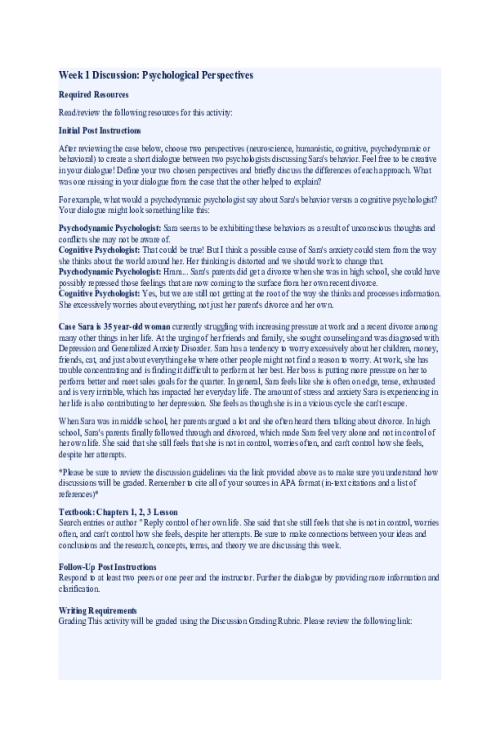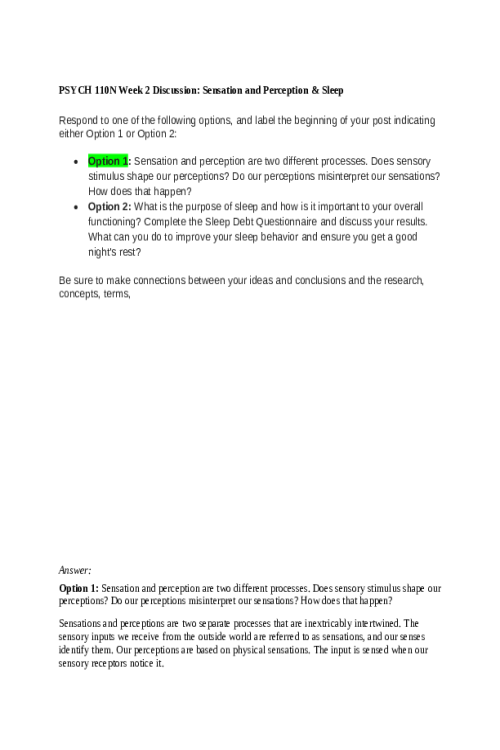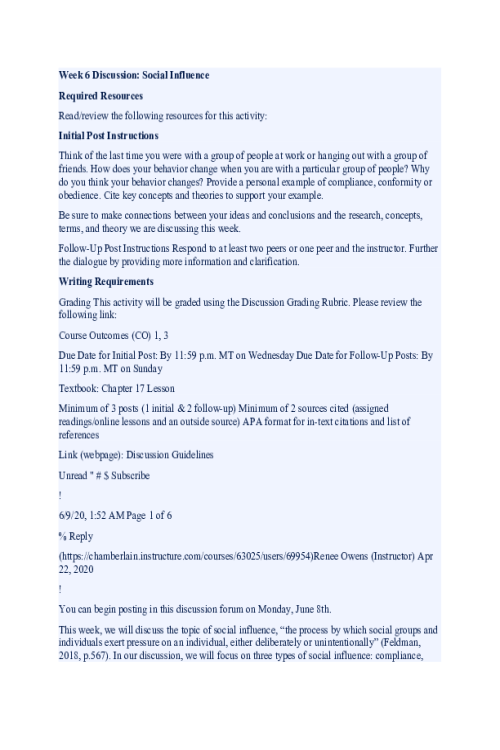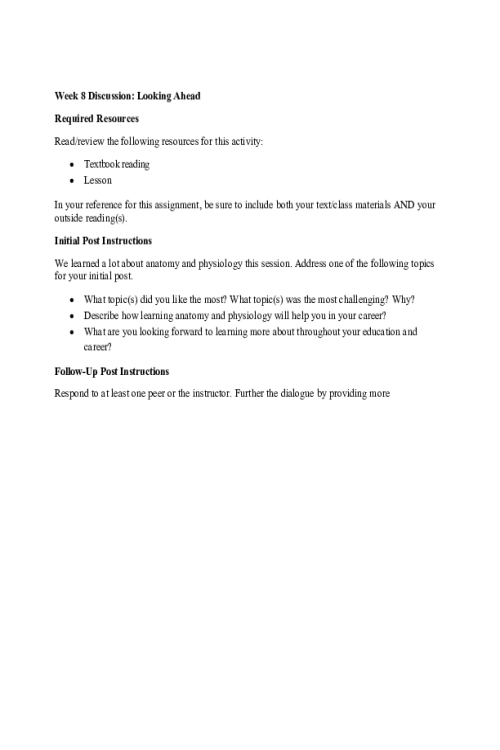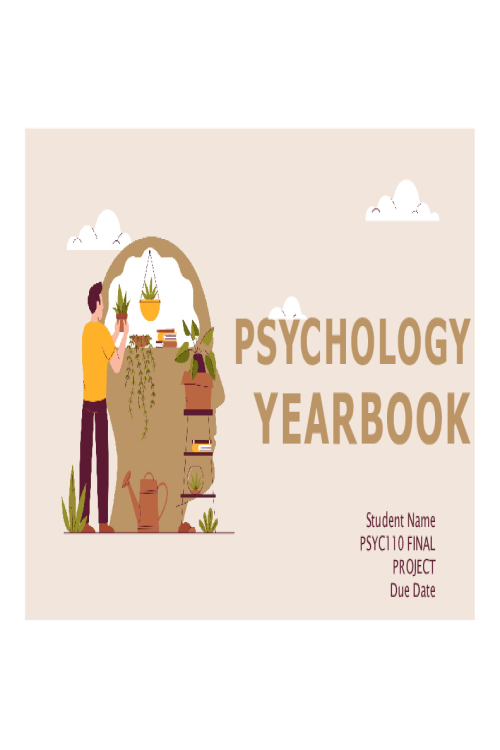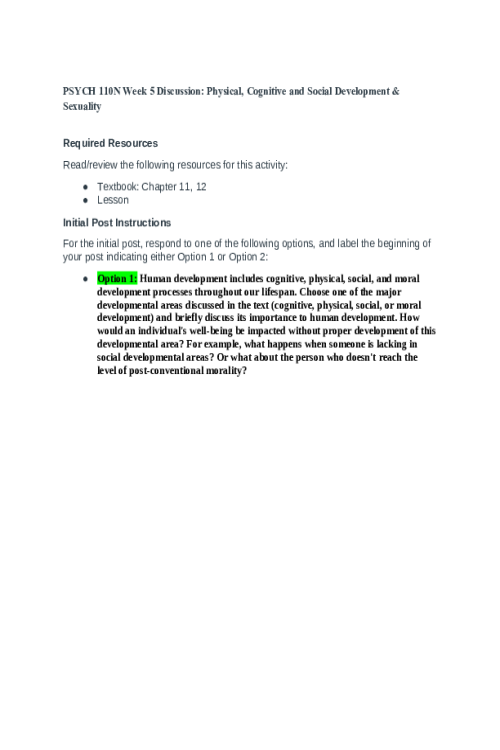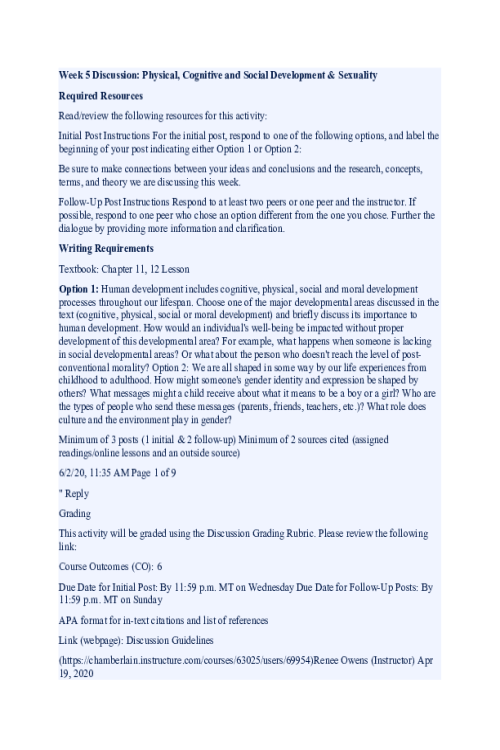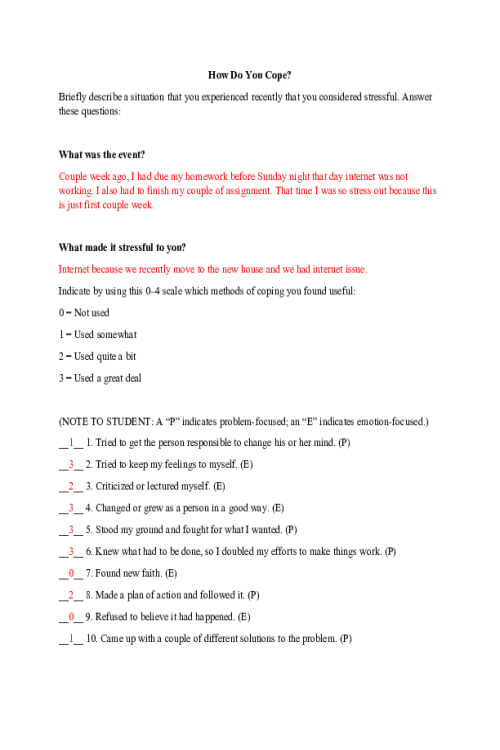PSYC 110N Week 8 Final Project; Psychology Yearbook
Week 8 PSYC110 Final Project Psychology Yearbook By: Student Name Assess Theoretical Perspectives Related to Human Behavior, including Physiological Explanations for Changes in Behavior When an individual is going through hormonal changes, recovering from surgery, or coming to grips with his or her health condition, his or her behavior may be influenced physiologically. Hormone imbalance and hormone replacement treatment have both been shown to have a significant impact on a person's behavior. When a person is told to stay in bed or is given drugs for post-surgery recuperation, their behavior changes. This type of behavior change is frequently accompanied by a dissatisfied and hopeless attitude that affects how a person reacts to himself and his surroundings. There are countless psychological theories because psychologists are continuously captivated by human behavior. The social cognitive-behavioral model, classical and operant conditioning, and socio-ecological theory are examples of theories. Analyze the Processes of Sensation and Perception and the Factors that Affect Consciousness. Sensation and perception are two separate but closely connected systems. Perception is the process through which the brain selects, organizes, and interprets information about the physical environment received by our sensory receptors. In other words, sensations constitute the physiological foundation of perception. Because each person's brain interprets stimuli differently based on their learning, memory, sentiments, and wants, different people may perceive the same sensations differently. Sensation & Perception Sensory receptors are specialized neurons that respond to specific sorts of stimuli. Sensory information is detected by a sensory receptor, which results in sensation (Fredman, 2018). Light that reaches the back of the eye, for example, causes chemical changes in the cells that line the back of the eye. The central nervous system receives messages from these cells in the form of action possibilities. Transduction is the process of converting sensory input energy into action potential (Fredman, 2018). The emotions, as well as the expectations. Vision, hearing, smell, taste, and touch are the five senses that a person has (somatosensation). The five senses definition turns out to be simplistic. Balance (the vestibular sense), bodily direction and motion (proprioception and kinesthesia), pain (nociception), and temperature information are all part of our sensory systems (thermoception) (Bradford, 2017). Factors The sensitivity of a sensory system to the relevant stimuli can be expressed using an absolute threshold. The absolute threshold is the amount of stimulus energy that must be present 50% of the time for the stimulus to be detected. Absolute thresholds are frequently calculated under extremely controlled conditions in instances where sensitivity is appropriate. While our sensory receptors are continually collecting environmental input, how we interpret that data has a significant impact on how we connect with the rest of the world. Perception refers to how cognitive information is structured, described, and consciously experienced (Feldman, 2018). Perception involves both bottom-up and top-down processing. Bottom-up processing is the process of constructing perceptions from sensory input. On the other hand, how we experience those feelings is influenced by our accessible knowledge, views, and attitudes. Examine the Physiological and Psychological Impact of Stress, and Various Techniques for Stress Management. Illustrate Models of Learning and Memory. Stress has the potential to negatively impact our lives. Headaches, intestinal issues, and sleep difficulties are all examples of physical disorders that might be induced. It can also cause psychological and emotional issues as perplexity, anxiety, and sadness. A person experiences stress when the body's internal balance is interrupted. The endocrine system kicks into high gear in order to secrete hormones, and the body prepares to fight or flee. Bering metabolizes a lot of energy and does it efficiently. However, these elevated hormonal levels can have long-term negative consequences, including immune system suppression, memory and cell communication problems in the brain, increased BBB permeability, and an increased risk of cardiovascular disease. Illustrate Models of Learning and Memory Learning Models Model of Rotation According to this paradigm, students in a single class tend to rotate between learning modalities and online learning at the discretion of the instructor. Learning takes place on a physical campus, according to this approach. Model of Flexibility Learners can create a unique, flexible plan that alternates between learning modalities and includes online learning as a foundation. Learners in the Flex Model, like those in the Rotation Model, primarily study on-campus, although each class is divided into online and offline components. Virtually Enriched Model Learning is separated into online and offline components in this paradigm, according to this model. While students and instructors must interact face to face, the Enriched Virtual Model does not need students to attend the campus every day. Memory Models Memory Model with Multiple Stores In 1968, Atkinson and Shiffrin created this model. Atkinson and Shiffrin use this model to try to explain how information flows between the sensory register (SR), short-term memory (STM), and long-term memory (LTM). Sensory information is processed in the SR, but only for a fraction of a second before it is lost. It's modality-specific in the sense that whichever sense is recorded determines how it's held as a result. If sensory information is attended to, it is encoded acoustically, visually, acoustically, or, less frequently, semantically in the STM for temporary storage. STM is estimated to have a capacity of 5-9 products with a processing time of 30 seconds. Chunking can be used to augment this capabilities. Memory Model with Working Memory Baddeley and Hitch (1974) created the Working Memory Model of Memory in order to give a more precise primary memory model. Working memory divides primary memory into several components, rather than thinking of it as a single, unified construct. The WMM was created on the concept that if we undertake dynamically diverse activities at the same time, we perform them poorly than if we do them separately, despite the fact that there is often no interference if you complete one visual and one aural activity at the same time. This means the STM is separated into two shops, one for visual processing and the other for sound processing. Analyze Key Theories on Motivation and Personality. Maslow's Hierarchy of Needs Theory Maslow's hierarchy of needs is a motivation theory that says that five sorts of human needs determine an individual's behavior (Fredman, 2018). Some of these requirements include physiological needs, protection needs, affection and belonging needs, confidence needs, and self-actualization wants. Maslow's theory depicts a pyramid-shaped hierarchy of requirements, with more high-level, intangible demands at the bottom and vital needs at the top. After a person's basic needs are addressed, he or she will move on to higher-level requirements. The Two Factors of Herzberg According to the theory, motivators (achievement, appreciation, job satisfaction, obligation, and prospects for advancement and growth) account for the majority of factors that contribute to job satisfaction, whereas hygiene elements account for the majority of factors that contribute to job dissatisfaction. According to Herzberg, motivating factors (also known as satisfiers) are inherent job components that contribute to fulfillment, such as accomplishment, appreciation, work (nature), obligation, development, and progress. These are factors that, if not addressed effectively, might lead to job discontent. Motivational Theories Psychoanalytic Personality, according to Sigmund Freud, is made up of three elements. Our impulse energy comes from the id. It is in control of both our requirements and our wants. According to Freud, the Id wants instant satisfaction of our cravings without recourse to reason or morality. Our most fundamental instinct is demanding, impulsive, blind, irrational, antisocial, selfish, and lust-driven (Fredman, 2018). The superego, or conscience, represents morality as well as societal norms. It comprises all of a person's desired values and makes us feel horrible if we don't achieve them. In a nutshell, the superego is our ideal self, the person we aspire to be (Souders, 2021). The ego attempts to balance the ineed d's for pleasure with the superego desire for perfection. It operates on the basis of reality, mediating the i and d's superego's clashing demands and selecting the best option. Trait This personality theory reveals your Transparency, or open-mindedness, as well as how much you enjoy trying new things. How correct is one's conscientiousness? Extraversion is a personality trait that refers to whether you derive your motivation from interacting with others (Souders, 2021). People that have a low extraversion score get their energy from within. Individuals provide vitality to extraverts. They appear to have the gift of gab and to be confident. How nice you are, or how courteous, tolerant, and sympathetic you are. Personality Theories Humanistic Maslow felt that rather than nature or nurture, personality was a question of personal preference. People, he felt, have free will and are driven to do things that will help them reach their full human potential. The humanistic perspective emphasized the need of exercising free choice in order to become the greatest human one can be (Fredman, 2018). It differs from previous theories in that it assumes that people are naturally healthy. Humanists believe that people are continually looking for new ways to develop, learn, and evolve, and that our personalities and behaviors are shaped by our choices. Social Cognition Instead of evolving in a black box, the theory of social cognition examines personality through the prism of our social interactions, so our character characteristics interact with our environment to shape behavior (Souders, 2021). This paints a much clearer picture of how our personalities are influenced by others. The social cognition theory was developed by Albert Bandura, a scientist. He felt that when people witness someone else benefiting from an action, they will want to replicate it in order to reap the same reward. Describe the Major Physical, Cognitive, and Social Developmental Changes that occur from Infancy to Adulthood. Human growth refers to a person's physical, cognitive, and psychosocial development over his or her lifetime, which includes physical, cognitive, and social changes. Because our brains do not mature in infancy or childhood, physical development frequently necessitates cerebral growth, which not only allows motor control in adolescence but also greater synergy between emotions and adult preparation (Fredman, 2018). Physical development includes puberty, sexual well-being, fertility, menopause, advancements in our senses, and primary vs secondary aging. Good eating and exercise habits are also vital at any age and level throughout one's life. Cognitive development includes mental processes, thinking, learning, and comprehension, and it does not stop in childhood (Fredman, 2018). Adolescents learn to think logically about complicated ideas and can practice their new cognitive talents by debating topics with adults. Moral reasoning, like practical intelligence, gets better with practice. Experience can help you gain wisdom. Memory and many types of intellect appear to improve with age. For cognitive processes, brain growth and the brain's ability to adjust and compensate for losses are also important over time. Temperament and attachment are important variables in social development, more emphasis should be placed on infants and caregivers. As the social environment evolves and the child grows psychologically, different forms of play and encounters with other children and teachers become increasingly significant. Psychosocial development includes emotions, attitude, self-esteem, and relationships. Peers are more crucial for teenagers who are exploring new roles and creating their own identities. Dating, romance, cohabitation, marriage, having children, and looking for work or a career are all components of the transition into adulthood. Family, friends, parenting, romance, divorce, remarriage, blended families, elder care, becoming grandparents and great grandparents, retirement, new careers, coping with losses, and death and dying are all developmental concerns that persist into adulthood. Describe Different Types of Psychological Disorders, Schools of Thought on Possible Causes, and How Society Responds to People Living with Mental Disorders. Anxiety Disorders Anxiety disorders are a type of mental illness that causes patients to have distressing and recurrent spells of anxiety and fear. Many people experience these ideas on a daily basis when they have to undertake things like public speaking or a job interview. People with anxiety disorders also experience same symptoms, but over a longer period of time, six months or more (WHO, 2019). Mood disorders Mood disorders are associated with an individual encountered feelings of sorrow, irritability, or a general case of the 'blahs'. Even as horrible emotions are common, individuals suffering from mood disorders live with more prolonged and severe symptoms and disturbance, and generally pass within a short period (WHO, 2019). People dealing with this mental disorder learn that almost every day, and sometimes for most of the day, their mood affects both mental and psychological well-being. Mood disorders affect the majority of people, but with proper diagnosis and care, they can live healthy, normal, and productive lives (Fredman, 2018). If left untreated, this disorder may have a detrimental effect on role functioning, quality of life, and a number of chronic physical health conditions including diabetes and heart disease. Psychological Disorders Schizophrenia & Psychotic Disorders Schizophrenia is a chronic brain disorder marked by significant alterations in cognitive and emotional function as well as disturbance. Schizophrenia has an impact on the most significant aspects of human life, such as language/communication, thinking, object perception, self-perception, and so on (WHO, 2019). Hearing voices, hallucinations, delusions, social withdrawal, incoherent speech, and aberrant reasoning are all symptoms of schizophrenia. Eating Disorders Eating disorders are serious, chronic conditions that can be life-threatening if left untreated. Typically, these disorders strike during puberty and primarily affect girls. Although eating disorders manifest in a variety of ways, including different symptoms and stages of development, they all include obsessive and often distressing thoughts and behaviors, such as eating less food, overeating, anxiety or depression, weight problems, body image problems, and low self-esteem (Fredman, 2018). Psychological Disorders Society’s Response to People People with mental illnesses are discriminated against in many public places merely because they are seen to be insane and incapable of interacting with others. People with mental illnesses are secluded in society, living amongst themselves and not interacting with others since no one is willing to tolerate them (Buchman-Wildbaum, et. al, 2020). The majority of them end up living in their isolated rooms, dying of starvation and poverty. Most corporate organizations only recruit persons who are sober in mind, so mentally incapacitated people go unemployed (Buchman-Wildbaum, et. al, 2020). As a result, these people are feared since they can have a bad attitude toward others, including injuring others and damaging property. References Bradford, A. (2017, October 24). The Five (and more) senses. LiveScience. Retrieved December 12, 2021, from https://www.livescience.com/60752-human-senses.html. Buchman-Wildbaum, T., Richman, M. J., Váradi, E., Schmelowszky, Á., Griffiths, M. D., Demetrovics, Z., & Urbán, R. (2020). Perceived loss among people living with mental disorders Cherry, K. (2020, March 19). Explore a list of psychological disorders from the DSM-5. Verywell Mind. Retrieved December 8, 2021, from https://www.verywellmind.com/a-list-of-psychological-disorders-2794776. Feldman, R.S. (2018). Understanding Psychology (14th ed.). Dubuque: McGraw-Hill Education. Souders, B. (2021, November 25). 20 most popular theories of motivation in psychology. PositivePsychology.com. Retrieved December 13, 2021, from https://positivepsychology.com/motivation-theories-psychology/. WHO. (2019, November 28). Mental disorders. World Health Organization. Retrieved December 16, 2021, from https://www.who.int/news-room/fact-sheets/detail/mental-disorders
Related Products
PSYC 110N Week 2 Discussion and Responses; Sensation and Perception & Sleep - Option 2
Contributor: Ashley Olsen
$15
PSYC 110N Week 4 Discussion; Motivation and Emotion & Theories of Personality - Option 1
Contributor: Ashley Olsen
$15
Related Products
PSYC 110N Week 4 Discussion and Responses; Motivation and Emotion & Theories of Personality - Option 1
Contributor: Ashley Olsen
$15
PSYC 110N Week 1 Discussion; Psychological Perspectives - Cognitive and Behavioral Dialogue Discussing Sara s behavior
Contributor: Ashley Olsen
$15
PSYC 110N Week 2 Discussion; Sensation and Perception & Sleep - Option 1
Contributor: Ashley Olsen
$15
PSYC 110N Week 2 Discussion and Responses; Sensation and Perception & Sleep - Option 2.
Contributor: Ashley Olsen
$15
PSYC 110N Week 7 Assignment; You Decide; Psychological Disorders Create a Case! - Obsessive-Compulsive Disorder (OCD)
Contributor: Ashley Olsen
$15
PSYC 110N Week 7 Assignment; You Decide; Psychological Disorders Create a Case! - Panic Disorder
Contributor: Ashley Olsen
$15
PSYC 110N Week 5 Discussion; Physical, Cognitive and Social Development & Sexuality - Option 1
Contributor: Ashley Olsen
$15
PSYC 110N Week 5 Discussion and Responses; Physical, Cognitive and Social Development & Sexuality
Contributor: Ashley Olsen
$15
PSYC 290N Week 5 Discussion; The Media and Communication in Young Adulthood
Contributor: Daniel Craig
$15
PSYC 290N Week 7 Assignment; Sexually Transmitted Infections in the Elderly
Contributor: Daniel Craig
$15
PSYC 290N Week 1 Discussion; Prenatal Development and Birth - Option 2 Teratogens
Contributor: Daniel Craig
$15
